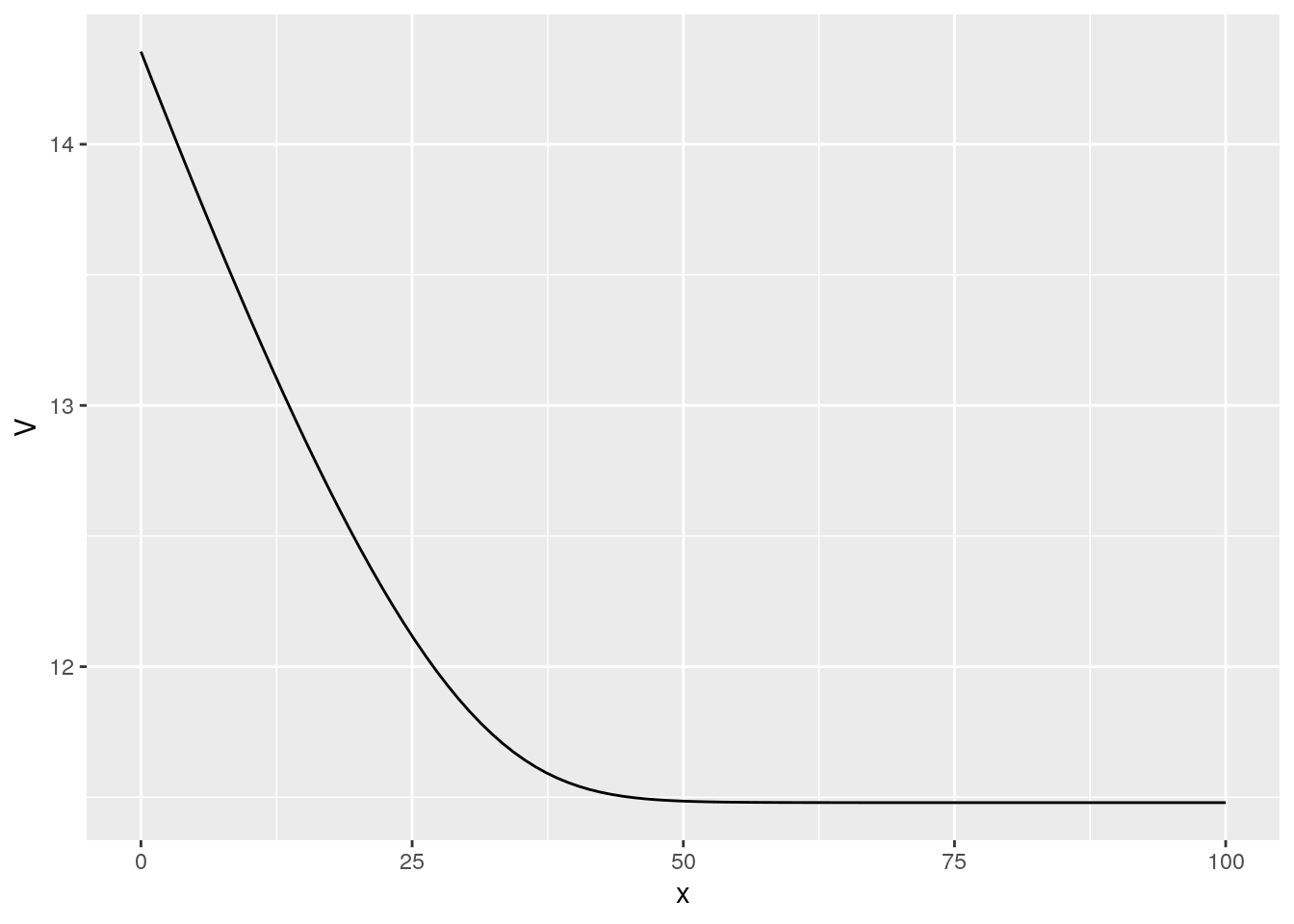Lab on Dynamic Discrete Choice
03 January, 2023
- Consider a simple saving problem (cake eating)
- Explain Bellman problem without uncertainty
- Explain Bellman problem with uncertainty
- Solve simple consumption saving problem
- Simulate transitory and permanent policies
- Plot a fit using some simple distance, an indirect inference estimator
We consider here discrete choices over a set of alernatives. The utility of the agent is modeled as
Cake eating
Imagine you a given a cake os size \(S\), and you need to decide how much to eat everyday. How would you formulate the problem?
\[ \max_{c_t} \sum_{t=0}^\infty \beta^t u( c_t) \quad s.t. \quad \sum_{t=0}^\infty c_t \leq S\] One can write the Lagrangian of this problem and find:
\[L = \sum_{t=0}^\infty \beta^t u( c_t) - \lambda \Big( \sum_{t=0}^\infty c_t - S \Big)\]
and when the error term is type 2 extreme value. This gives the following FOCs:
\[ \beta^t u'(c_t) = \lambda \]
Consider a CRRA utility function \(u(c)=\frac{c^{1-\gamma}}{1-\gamma}\) which gives $ u’(c)=c^{-}$ and hence \[ \sum_{t=0}^\infty c_t = \sum_{t=0}^\infty \Big( \frac{\lambda}{\beta^t} \Big)^{-\frac{1}{\gamma} } = \frac{\lambda^{-\frac{1}{\gamma}}}{1-\beta^{1/\gamma-1}} =S \] hence we get that the consumption will be
\[c_t = \Big( \frac{\lambda}{\beta^t} \Big)^{-\frac{1}{\gamma} } = (1-\beta^{1/\gamma-1})\beta^{t/\gamma}S\]
We can easily plot this for different values of \(\beta\) and \(\gamma\)
library(data.table)
library(ggplot2)A recursive formulation
Let’s introduce \(V(S)\) as the present value, the life time value of having a cake of size \(S\) today and consuming optimally in the future.
\[V(S) = \max_{c_t} \sum_{t=0}^\infty \beta^t u( c_t) \quad s.t. \quad \sum_{t=0}^\infty c_t \leq S\] But note that
\[V(S) = \max_{c} u(c) + \beta V(S-c) \]
The bus engine problem
Imagine that we want to model the decision to replace the engine on in a fleet of buses.
- the state is \(x_t\), the mileage of the bus
- every period, the bus delivers profit as a function of \(x_t\), call it \(p(x_t)\)
- the bus owner Mr Zurcher, can decide to replace the engine at cost \(C\) in which case \(x_t\) goes back to \(0\)
- the bus dies with probability a function of \(x_t\) in which case the owner gets \(0\)
- the owner discounts at rate \(\beta\)
Using our Bellman tool we can write the optimal decision for this problem recursively:
\[ V(x) = \max \{ p(x) + \lambda(x)\beta V(x+u) , -C + \beta V(0) \} \] We can see that this will have a threshold property. In practice the decision won’t be as clear as a simple threshold. We want to allow for some randomness. We then add a logit preference shock \(\xi\) to the different between the two options. We then remember that we can transform the max into a log-sum-exp.
\[ V(x) = \log\Big( \exp \Big[p(x) + \lambda(x)\beta V(x+u)\Big] + \exp \Big[ -C + \beta V(0) \Big] \Big) + \gamma \]
There is not hope to solve this problem in closed form. We tackle it numerically.
n = 100
V = rep(0,n)
x = seq(0,100,l=n)
lambda = 1/(1+exp(0.1*(x-50)))
beta = 0.9
C = 2
P = exp(-0.01*x)
In = c(2:n,n)
rr = data.frame()
for (i in 1:300) {
rr = rbind(rr,data.frame(x=x,V=V,rep=i,v1=P + lambda*beta*V[In],v2=-C + beta*V[1] ))
V2 = log( exp( P + lambda*beta*V[In]) + exp(-C + beta*V[1] ) ) + 0.56
dist = mean((V2-V)^2)
V=V2
}
rr = data.table(rr)
ggplot(rr[rep<100],aes(x=x,y=V,group=rep,color=factor(rep))) +
geom_line()
ggplot(rr[rep==20],aes(x=x,y=v1,group=rep,color=factor(rep))) +
geom_line() +geom_hline(aes(yintercept =v2,color=factor(rep)) )
# we can look at the probability to replace
rr2 = data.frame(x=x,V=V,rep=i,v1=P + lambda*beta*V[In],v2=-C + beta*V[1] )
ggplot(rr2,aes(x=x,y=1/(1+exp(v1-v2)))) + geom_line()
ggplot(rr2,aes(x=x,y=V)) + geom_line()
simulating data
PR1 = 1/(1+exp( P + lambda*beta*V[In] - (-C + beta*V[1])))
rr = data.frame()
for (i in 1:100) {
rrr = data.frame()
x=1
l=1
R=0
for (t in 1:100) {
if (l==0) {
rrr = rbind(rrr,data.frame(i=i,t=t,x=0,l=0,profit=0,R=0))
next
}
# draw the maintenance choice
if (PR1[x]>runif(1)) {
R=1
profit = -C
} else {
R=0
profit = P[x]
if (lambda[x]<runif(1)) {
l=0
}
}
rrr = rbind(rrr,data.frame(i=i,t=t,x=x,l=1,profit=profit,R=R))
if (R==1) {
x=1
} else {
x= x+1
}
}
rr = rbind(rr,rrr)
}
data = data.table(rr)
data[,sum(l==1),i][,mean(V1)]## [1] 59.12ggplot(data[i==5],aes(x=t,y=profit)) + geom_line()
Writing a likelihood
We can write the likelihood of the decision and miles and sum accross individuals
lik <- function(theta) {
n = 100
V = rep(0,n)
x = seq(0,100,l=n)
lambda = 1/(1+exp(0.1*(x-50)))
beta = 0.9
C = theta
P = exp(-0.01*x)
In = c(2:n,n)
rr = data.frame()
for (i in 1:100) {
rr = rbind(rr,data.frame(x=x,V=V,rep=i,v1=P + lambda*beta*V[In],v2=-C + beta*V[1] ))
V2 = log( exp( P + lambda*beta*V[In]) + exp(-C + beta*V[1] ) ) + 0.56
dist = mean((V2-V)^2)
V=V2
}
Pr =1/(1+exp( P + lambda*beta*V[In] - (-C + beta*V[1])))
data[l==1,sum(log(Pr[x])*(R==1) + log(1-Pr[x])*(R==0)) ]
}
V = sapply(seq(1,3,l=30),lik)
plot(seq(1,3,l=30),V)